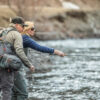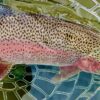
The summer symphony season has concluded but the sonorous waters of the Sun Valley region continue to flow in harmony with the rhythms of the day. The hum of bugs can be heard both early and late and the staccato clatter of hoppers fill the air throughout the day. Those anglers who attune themselves with the bug activity of August will find the most success. So whether you are attending the Sun Valley Writers Conference, playing a few rounds of golf, or flying off the top of Baldy plan on spending some time fly fishing our local waters.
Silver Creek
It is Trico time on the Creek. Typically this is the week the Tricos peak and the spinner falls can be spectacular lasting up to an hour and a half or more. If you make the morning pilgrimage, plan on arriving as early as 7:30AM and look for the clouds of Tricos to begin falling once the air temperature hits 70. Start by looking for fish plucking off the vulnerable Trico duns with a white or olive bodied Harrop’s Trico Dun size 20 or 22. Once the bugs get heavy with eggs, they will lower over the water and the spinner fall is on. At this stage in the hatch, it is best to switch to a Trico spinner pattern in black or white size 20, 22, or 24. Remember in order to achieve the best drag free presentation, position yourself above the pods of rising trout and use a slack line cast to place your pattern above the lead fish. If you are having trouble seeing your fly, use some Frogs Fanny to help it float or tie your Trico off the back end of a larger PMD or other sighter fly. Be persistent and patient and you will be rewarded. Of course, some mornings the Baetis (size 22) will outnumber the Tricos. Just check your waders or the underside of your tube for these diminutive brown bugs. Fortunately, Harrop’s Paraspinner covers both of these bugs. After the complex morning hatch comes to a conclusion, stick around for the possibility of Damsels or Callibaetis Spinners. It is also time to start searching the banks with hoppers as well as beetles and ants. Even though the days are getting shorter, the evening fishing can be fantastic and without the crowds of the morning frenzy. One final thought…as the water warms up, please land and release the fish as quickly as possible.
Big Wood River
The Wood has also fallen into the typical August rhythm with fishing being best early and late. In the mornings, some Tricos are beginning to appear along with Baetis, small cream colored Crane Flies, micro caddis, occasional Pink Alberts and Rusty Spinners. Look for sipping fish in the slow, shallow tail outs of runs or along the seams of fast water. You will also find active feeders hanging off the drops at the head of the riffles. If you can’t find risers, search the water with red and black zebra midges, small pheasant tails, rainbow warriors, or Bishop’ Dynamite in size 16 and 18 trailed behind an attractor dry such as a Turk’s Tarantula. As the day heats up, probe the shallow rifles with hoppers and small nymphs. In the evening, look for the caddis to return. To match these bugs try a tan caddis in size 16 or 18. For a change of pace, you might try using a Tenkara Rod. This traditional Japanese fishing technique is extremely effective and a lot of fun.



Big Lost River below Mackay
With flows just below 400 CFS, access is still limited and wading can be a challenge. But if you do decide to make the trek, the fishing is best during the pleasant times of day when the bugs are hatching. After the morning hatch is done the fishing can really slow down, but searching the riffles with nymphs can be productive. Be sure to have Crane Flies, Baetis (size 18-20), PMDs (size 16) and Larimer’s Yellow Sallies (size 14.5) and an assortment of nymphs such as King Princes (size 12, 14), San Juan Worms, Flashback Pheasant Tails (size 14, 16), and Bishop’s Dynamite (size 14, 16, 18). There can also be a very good morning Trico hatch and skating large Crane Flies can be really fun. In the evening, caddis are the main course and the last hour of light can be really productive.
Upper Big Lost
The water has dropped dramatically and the entire river is very easy to move about. The fishing is following the same pattern as the Wood with fishing being best early and late. Anglers are catching quality Rainbows, Cutbows, Brook Trout, Cutthroat and Whitefish. Still, the reports from this area have been mixed. Some anglers are finding success while others are being frustrated. To be successful, just keep moving around to find the fish; search the water with drys and dry dropper rigs and you will find the fish. These fish are opportunistic feeders and will usually give an attractor dry fly a try, but they may only give you one chance. Take along an assortment of your favorite attractor dry flies and nymphs as well as your standard parachute patterns: Parachute Hare’s Ear, Turk’s Tarantulas, PMX, Royal Wulffs, King Prince, Flashback PTs and Zebra Midge.
Salmon River
Any day now Fish and Game will restrict the floating of this section of river to protect the spawning Chinook and at the moment the fire outside of Stanley has not affected the area beyond some lingering smoke. For the next week the fishing will remain very good. For flies, take Large Yellow and Orange Stimulators and attractors such as Turk’s Tarantula. Also, the Spruce Moth is now a major player and can provide excellent dry fly fishing. If you choose to wade fish, there are plenty of pull offs to park your car and search this wonderful fishery.
Warm Springs & Trail Creek
These rivers are low and provide a great alternative for those seeking a small stream experience but don’t have the time to drive over the hill to the Upper Lost. Fish and Game has stocked these rivers around the bridges and anywhere the rivers near the road. If you wish to seek wild fish, just leave the beaten path and explore. Expect to see PMDs, Pink Alberts, Caddis, Small Stone flies, and some Spruce Moths.
South Fork of the Boise
The flows are holding steady at 1800 CFS and fishing from a boat is going to be your best option. Still, you are better off parking the boat and working the banks and side channels. Expect to find caddis in the late afternoons into the evenings as well as and Pink Alberts and Flavs. Also, nymphing with caddis larva, PTs, and zebra midge can be a good option when no bugs present. You might try ripping a streamer through some deeper runs in search of a Bull Trout or an aggressive Bow.
Alpine Lakes
If you want to beat the summer heat, you might try hiking into one of our numerous Alpine Lakes. The midge hatches can be prolific and on windy days ants, beetles, and spruce moths will find their way on to the surface. Scan the edges for cruisers or look for fish congregated at the inlets and outlets. For an idea about where to go just inquire in our shop.
[vimeo]https://vimeo.com/29957415[/vimeo]

Printable List
Everyone should believe in something. I believe I’ll go fishing.~ Thoreau
photo by Bryan Huskey



